Environmental Public Health Tracking Work Plan Template
Environmental Public Health Tracking Network (Tracking Network)
Att5a_Environmental Public Health Tracking Work Plan Template_2019_tracked changes.xlsx
Environmental Public Health Tracking Work Plan Template
OMB: 0920-1175
⚠️ Notice: This form may be outdated. More recent filings and information on OMB 0920-1175 can be found here:
Document [xlsx]
Download: xlsx | pdf
EH1702 Strategies&Activities
PM Guidance
PM Reporting





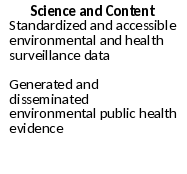

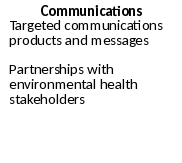

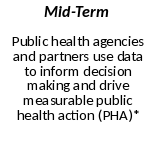



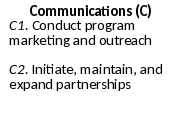
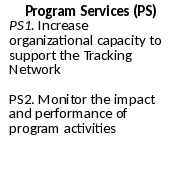

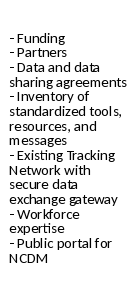










Overview
EH1702 Logic ModelEH1702 Strategies&Activities
PM Guidance
PM Reporting
Sheet 1: EH1702 Logic Model

|
EH17-1702 Enhancing Innovation and Capabilities of the Environmental Public Health Tracking Network | |||||||||||||||||
| EH17-1702 Logic Model | ||||||||||||||||||

|
||||||||||||||||||













Sheet 2: EH1702 Strategies&Activities

|
||
| CDC-RFA-EH17-1702 Strategies and Activities |
||
| Activities in the EH17-1702 NOFO fall into four broad categories: Science and Content, Technology and Informatics, Communications, and Program Services and encompass several strategies. Ongoing activities in each strategy should be informed by work across the entire program and grantee’s priorities. For example, Communications activities should be tailored to reflect activities in Science and Content. These activities should lead to the outputs listed in the logic model. Recipients need to demonstrate that 100% of the core activities are in place by the end of Year 1. Recipients must maintain all core activities each year. Recipients must also select and implement at least two new advanced activities per year. All advanced activities must be implemented and maintained by the end of Year 5. |
||
| SCIENCE AND CONTENT | Science and Content Strategy I (SC1) | |
| Identify and Integrate Public Health and Environmental Data | ||
| 5 Core Activities | 1 Advanced Activity | |
| SC1.A | SC1.F | |
| Identify and evaluate the strengths and limitations of health, exposure, environmental, and other data for the Network, in addition to work conducted as part of the Content Workgroup | Address gaps or limitations in available data by collaborating with state and local programs to optimize data collection and ensure the inclusion of data elements relevant to environmental public health tracking; integrating novel or non-traditional data determined to be relevant and of sufficient quality (e.g., electronic health record data); conducting analyses and activities that either fills the identified data gap or extends the applicability of the available data; or expanding the availability and utility of sub-county data and measures |
|
| SC1.B | ||
| Integrate data into grantee’s Tracking Network and ensure the availability and accessibility of data as appropriate for program staff and internal and external partners | ||
| SC1.C | ||
| Maintain existing and newly adopted Nationally Consistent Data and Measures (NCDM) requirements including maintenance of NCDM data within the grantee tracking network, submission of NCDM data to CDC, and dissemination of required NCDM measures via grantee’s Tracking Network https://www.cdc.gov/nceh/tracking/foa.htm | ||
| SC1.D | ||
| Disseminate additional indicators and measures to address grantee’s priorities, optional NCDMs or other agreed-upon standards | ||
| SC1.E | ||
| Collaborate with CDC, data stewards, data users, and other tracking grantees to improve existing NCDMs and, adopt new and optional NCDMs as developed by the Content Workgroup | ||
| Science and Content Strategy II (SC2) | ||
| Analyze and Apply Data to Translate Science Into Action | ||
| 2 Core Activities | 2 Advanced Activities | |
| SC2.A | SC2.C | |
| Conduct routine descriptive analysis of Tracking data to evaluate quality and completeness of data; to examine state and local environmental public health issues; or to generate information for other state and local programs, state and local decision makers, and the general public | Conduct routine analyses using Tracking data for the discovery of spatial, temporal, and demographic patterns of diseases, exposures, or environmental hazards; the timely identification of unusual events signaling the need for further investigation; or the non-research purposes of analyzing or linking health, exposure, and hazard data to help provide new insights or solutions to environmental health issues |
|
| SC2.B | SC2.D | |
| Use Tracking data to identify and prioritize the jurisdiction’s environmental public health concerns and priorities, and need for action to help direct Tracking program activities including but not limited to those listed in this FOA | Apply and interpret Tracking data to inform the development and evaluation of public health actions |
|
| TOTALCORE ACTIVITIES FOR SCIENCE AND CONTENT: 7 | TOTAL ADVANCED ACTIVITIES FOR SCIENCE AND CONTENT: 3 | |
| TECHNOLOGY AND INFORMATICS |
Technology and Informatics Strategy I (TI1) | |
| Maintain and Enhance Information Technology Infrastructure | ||
| 5 Core Activities | 2 Advanced Activities | |
| TI1.A | TI1.F | |
| Maintain a web-based publicly available environmental health tracking system that complies with CDC grantee portal requirements | Establish repeatable, reliable, and readily accessible electronic access to data sources, including tools and processes to increase the availability and accessibility of timely and locally relevant data (e.g., sub-county and real time data) and any needs discovered as the result of the gap analysis |
|
| TI1.B | TI1.G | |
| Develop tools and processes to improve and promote the quality, usefulness, availability, and timeliness of data | Increase data management efficiency by developing state/local standard operating procedures and increasing the use of routine, reusable, and electronic processes and scripts for obtaining, validating, and disseminating data, including use of application programming interfaces |
|
| TI1.C | ||
| Evaluate informatics needs and conduct a gap analysis to address barriers to the effective use of data for environmental public health decision making (or by environmental public health decision makers) | ||
| TI1.D | ||
| Maintain the technology infrastructure and resources to submit Tracking NCDMs to CDC during scheduled data calls | ||
| TI1.E | ||
| Work with informatics and IT resources within the grantee’s organization to ensure program informatics/IT activities align with organizational strategies and objectives | ||
| TOTALCORE ACTIVITIES FOR TECHNOLOGY AND INFORMATICS: 5 | TOTALTECHNOLOGY AND INFORMATICS ADVANCED ACTIVITIES: 4 | |
| COMMUNICATIONS | Communications Strategy I (C1) | |
| Conduct Program Marketing and Outreach | ||
| 7 Core Activities | 2 Advanced Activities | |
| C1.A | C1.H | |
| Develop and implement an annual communication plan that includes a risk communication plan; specific, measurable, achievable, realistic, time-bound (SMART) objectives; and targets key tracking audiences including data stewards, state and local health department staff, policymakers, technical advisory group, relevant community groups or non-governmental organizations | In the communications plan, include at least one collaborative communication activity, in addition to the program-wide activity, with one or more Tracking grantees (e.g., co-presenting at a meeting; coordinated communication about a specific topic or awareness event) |
|
| C1.B | C1.I | |
| Participate in one coordinated, program-wide communication activity (e.g., Tracking Awareness Week) each year | Conduct a needs assessment with target audience(s) to inform development of at least two custom communication products (e.g., messages, tools) to communicate Tracking data and information. Products may include, but are not limited to fact sheets, environmental health snapshots, infographics, newsletter articles, and social media posts |
|
| C1.C | ||
| Provide regular, periodic updates and announcements at least quarterly about grantee tracking activities to partners and stakeholders via email distribution (e.g., list-serv, e-newsletter) or other mechanism | ||
| C1.D | ||
| Utilize social media (e.g., Facebook, Twitter, blogs) at least quarterly, either from program accounts, agency accounts, or partner accounts | ||
| C1.E | ||
| Present information about the Tracking Program (national and grantee), national and local Tracking Networks, data, data use (e.g., public health actions), and activities annually including: exhibiting at a meeting or conference; conducting at least one webinar to an external (outside the health department) audience; and presenting at national, regional, or local meetings or conferences | ||
| C1.F | ||
| Maintain existing and add new content/messaging about NCDM and other data as needed to Tracking Network websites in order to provide plain language interpretations of data and results to target audiences | ||
| C1.G | ||
| Disseminate existing Tracking communication messages and products (e.g., grantee profile, data highlights, community health reports, communication toolkits) to appropriate audiences | ||
| Communications Strategy II (C2) | ||
| Initiate, Maintain, and Expand Partnerships | ||
| 3 Core Activities | 2 Advanced Activities | |
| C2.A | C2.D | |
| Develop and implement a partnership plan to engage new/innovative external partners (e.g., accountable care organizations, big data providers, new commercial technology and service providers in consumer-driven healthcare); and non-traditional public sector organizations (e.g., Tribal Nations, Department of Transportation) | Establish and maintain relationships with local media (i.e., newspapers, magazines, TV to promote Tracking through earned media) | |
| C2.B | C2.E | |
| Maintain Technical Advisory Group to inform decisions about Tracking Program data, data analysis, communication messages and products, etc. (minimum of one meeting per year) | Co-present/co-sponsor a national or regional meeting/conference or webinar with other grantees or partners | |
| C2.C | ||
| Establish and maintain relationship with at least one university/college program. Possible collaborations could include, but are not limited to, guest lecturing; mentoring students; co-presenting (webinar/meeting/conference); collaborating on GIS, data analysis, or other projects | ||
| TOTAL CORE ACTIVITIES FOR COMMUNICATIONS: 10 | TOTAL ADVANCED ACTIVITIES FOR COMMUNICATIONS: 4 | |
| PROGRAM SERVICES | Program Services Strategy I (PS1) | |
| Increase Organizational Capacity to Support the Tracking Network | ||
| 3 Core Activities | 1 Advanced Activity | |
| PS1.A | PS1.D | |
| Lead, support, and maintain existing Environmental Public Health Tracking Program within state and/or local jurisdictions | Develop and implement program-specific training opportunities, through Web-based or in-person training modules or other product (e.g., video tutorial) and internships/fellowships/mentorships for students in environmental public health tracking |
|
| PS1.B | ||
| Identify and prioritize technical and capacity needs among state and local Tracking Program staff to inform provision of more targeted resources and training opportunities | ||
| PS1.C | ||
| Support and facilitate training of the state and local public health workforce and partners on basic Tracking principles to establish a common understanding of the Tracking Program | ||
| Program Services Strategy II (PS2) | ||
| Monitor the Impact and Performance of Program Activities | ||
| 4 Core Activities | No Advanced Activities | |
| PS2.A | ||
| Document and submit public health actions quarterly (if available), but at a minimum of twice a year, to show program impact | ||
| PS2.B | ||
| Develop and implement an annual evaluation plan, based on CDC's provided template, that clearly identifies accomplishments and guides implementation efforts | ||
| PS2.C | ||
| Assist the CDC Tracking Program in conducting annual portal reviews | ||
| PS2.D | ||
| Collect and submit a report of website statistics on the public Tracking website using standard web statistics established by the Tracking Program twice a year | ||
| TOTALCORE ACTIVITIES FOR PROGRAM SERVICES: 7 | TOTAL ADVANCED ACTIVITIES FOR PROGRAM SERVICES: 1 | |
| TOTAL CORE ACTIVITIES FOR ALL CATEGORIES: 29 | TOTAL ADVANCED ACTIVITIES FOR ALL CATEGORIES: 12 | |
Sheet 3: PM Guidance

|

|
||||||||||||||||||||
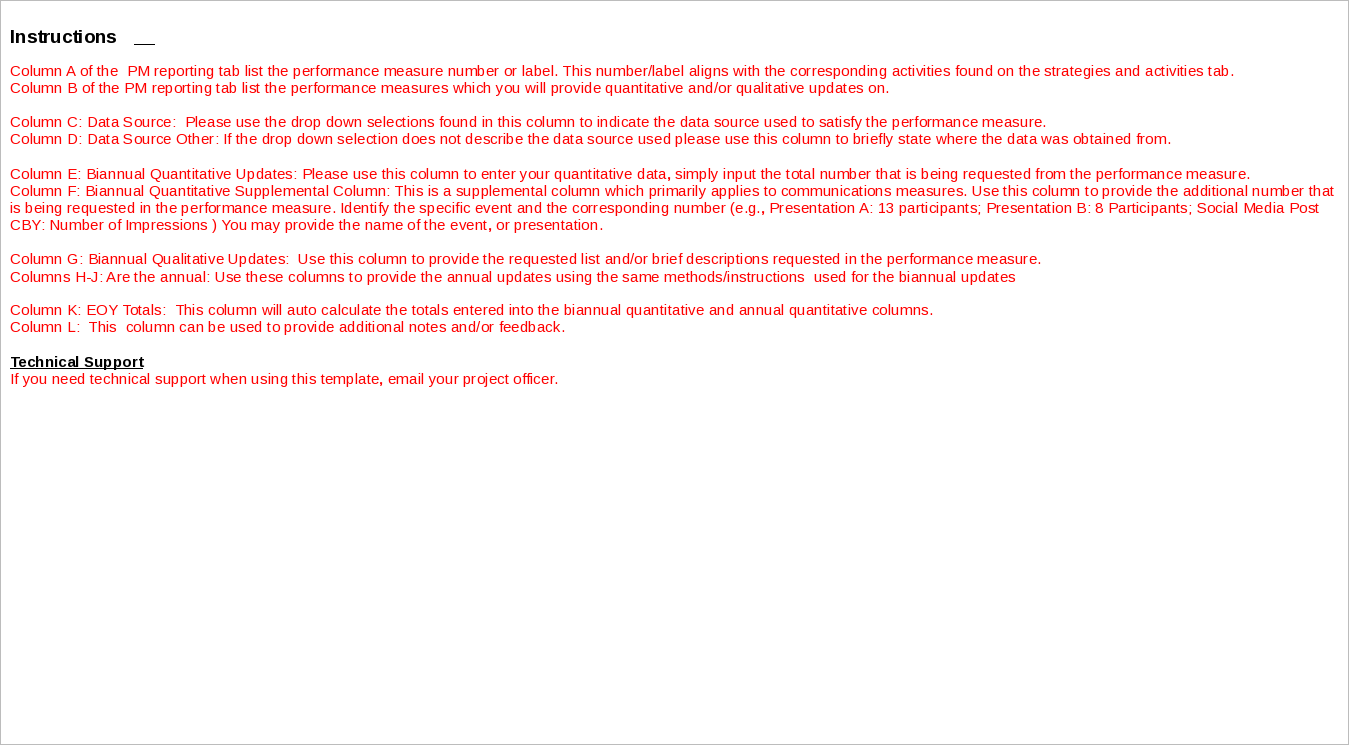
|
|||||||||||||||||||||


Sheet 4: PM Reporting

|
||||||||||||||||||||
| Measure Number of Label | Performance Measures | Data Source (Drop Down Options) | Data Source Other | Year 1 Results | ||||||||||||||||
| Biannual Quantitative Update | Biannual Quantitative Supplemental Information | Biannual Qualitative Update | Annual Quantitative Update | Annual Quantitative Supplemental Information | Annual Qualitative Update | E0Y Total | Notes or Feedback | |||||||||||||
| What is(are) the data source(s) related to the performance measure? | If you've indicated other in the previous data source column, please use this space to provide the data source | Please Enter the Corresponding Number into the Template | e.g. # of impressions, # of participants, # of visitors | Please enter the List, Brief Description, or Yes/NO response | Please Enter the Corresponding Number into the Template | e.g. # of impressions, # of participants, # of visitors | Please enter the List Brief Description, or Yes/NO response | Automatically Calculated | ||||||||||||
| Science and Content (SC)-10 | ||||||||||||||||||||
| SC1.A | List: 1. 2. 3. 4. 5. 6. 7. 8. 9. 10. |
List: 1. 2. 3. 4. 5. 6. 7. 8. 9. 10. |
0 | |||||||||||||||||
| SC1.B | 0 | |||||||||||||||||||
| 0 | ||||||||||||||||||||
| SC1.C | SC: Number of required NCDM datasets integrated into grantee Tracking Network with all required elements and accessible by appropriate program staff | 0 | ||||||||||||||||||
| SC: Number of required NCDM datasets integrated into grantee Tracking Network with advanced elements and accessible by appropriate program staff. | 0 | |||||||||||||||||||
| SC1.D | List: 1. 2. 3. 4. 5. 6. 7. 8. 9. 10. |
List: 1. 2. 3. 4. 5. 6. 7. 8. 9. 10. |
0 | |||||||||||||||||
| List: 1. 2. 3. 4. 5. 6. 7. 8. 9. 10. |
List: 1. 2. 3. 4. 5. 6. 7. 8. 9. 10. |
0 | ||||||||||||||||||
| SC2.A | SC: Number of Tracking datasets for which routine descriptive analyses are conducted | 0 | ||||||||||||||||||
| SC2.B | SC: Number and description of program activities developed, informed, or improved by analysis of Tracking datasets | Brief Description | Brief Description | 0 | ||||||||||||||||
| Broad/Comprehensive Measure for Strategy SC2 | SC: Number of analyses (routine or other) conducted using Tracking datasets which resulted in a disseminated report, or publication | 0 | ||||||||||||||||||
| Advanced Activity | ||||||||||||||||||||
| SC1.F | Number and description of data gaps or limitations addressed | Brief Description | Brief Description | 0 | ||||||||||||||||
| SC2.C | Number and description of routine analyses (beyond descriptive analysis) that discover patterns, identify potential concerns, or otherwise provide new insights or solutions for environmental public health | Brief Description | Brief Description | 0 | ||||||||||||||||
| SC2.D | Number and description of either (1) planned public health actions developed/informed or (2) past public health actions evaluated by analyses conducted using Tracking datasets | Brief Description | Brief Description | 0 | ||||||||||||||||
| Short-Term Outcome | ||||||||||||||||||||
| Health and environmental data are accessed and used by internal and external audiences | 0 | |||||||||||||||||||
| SCST: Number of and Description of data requests made by partners | Brief Description | Brief Description | 0 | |||||||||||||||||
| Development of targeted jurisdiction-specific program activities based on generated evidence | SCST:Number of jurisdiction specific activities developed based on Tracking data or analysis.( year 1 serves as baseline, will determine increase for Year 2) | 0 | ||||||||||||||||||
| Technology and Informatics (TI)-4 | ||||||||||||||||||||
| T1.B | TI: Number of new tools and processes developed to improve the quality, usefulness, availability, and timeliness of data related to grantee Tracking systems | 0 | ||||||||||||||||||
| TI1.C | Brief Description | Brief Description | ||||||||||||||||||
| TI1.D | TI: Submission of complete standardized NCDMs to CDC during scheduled data calls. | |||||||||||||||||||
| Advanced Activity | ||||||||||||||||||||
| TI1.F | TIAA: Number of new tools and processes developed to improve the quality, usefulness, availability, and timeliness of data (refers to the development of advanced tools) | 0 | ||||||||||||||||||
| Short-Term Outcome | ||||||||||||||||||||
| TIST: Adherence to 100% of the required portal standards found in the Portal Requirements and Recommendations document. | ||||||||||||||||||||
| Communications (COMM)-6 | ||||||||||||||||||||
| C1.B | Brief Description | Brief Description | ||||||||||||||||||
| C1.C | 0 | |||||||||||||||||||
| REVISION | Number of program announcements/updates disseminated by medium/channel (e.g., listserv, email, social media, etc.) | 0 | ||||||||||||||||||
| C1.D | 0 | |||||||||||||||||||
| C1.E | 0 | |||||||||||||||||||
| 0 | ||||||||||||||||||||
| C1.G | List: 1. 2. 3. 4. 5. 6. 7. 8. 9. 10. |
List: 1. 2. 3. 4. 5. 6. 7. 8. 9. 10. |
0 | |||||||||||||||||
| REVISION | Number of presentations and exhibiting events with number of participants in each | |||||||||||||||||||
| REVISION | List of new and existing internal and external partners (listed by organization name) | |||||||||||||||||||
| List: 1. 2. 3. 4. 5. 6. 7. 8. 9. 10. |
List: 1. 2. 3. 4. 5. 6. 7. 8. 9. 10. |
0 | ||||||||||||||||||
| C2.B | 0 | |||||||||||||||||||
| C2.C | Brief Description | Brief Description | 0 | |||||||||||||||||
| Advanced Activity | ||||||||||||||||||||
| C1.H | List: 1. 2. 3. 4. 5. 6. 7. 8. 9. 10. |
List: 1. 2. 3. 4. 5. 6. 7. 8. 9. 10. |
||||||||||||||||||
| C1.I | COMMAA: List of developed communications products based on results of completed needs assessment |
List: 1. 2. 3. 4. 5. 6. 7. 8. 9. 10. |
List: 1. 2. 3. 4. 5. 6. 7. 8. 9. 10. |
|||||||||||||||||
| C2.D | Brief Description | Brief Description | ||||||||||||||||||
| C2.E | 0 | |||||||||||||||||||
| Short-Term Outcome | ||||||||||||||||||||
| Increased awareness of the Tracking Network and environmental health issues | COMMST: Increase in Outreach Efforts: Presentations, Exhibits, Trainings (increase based on jurisdiction’s previous years) | |||||||||||||||||||
| COMMST: 10% increase in required Overall Usage web statistics (increase based on previous year) | ||||||||||||||||||||
| Engaged partners and users | (e.g., guest lecturing; mentoring students; co-presenting (webinar/meeting/conference)collaborating on GIS, data analysis, or other projects |
Brief Description | Brief Description | |||||||||||||||||
| Program Services (PS)-9 | ||||||||||||||||||||
| PS1.A | 0 | |||||||||||||||||||
| PS:Number of personnel supported directly and in-kind under this cooperative agreement | 0 | |||||||||||||||||||
| PS1.B | PS:Number & List of internal and external technical assistance requests completed* to the state health department, local health departments, and other public health system partners | List: 1. 2. 3. 4. 5. 6. 7. 8. 9. 10. |
List: 1. 2. 3. 4. 5. 6. 7. 8. 9. 10. |
0 | ||||||||||||||||
| List: 1. 2. 3. 4. 5. 6. 7. 8. 9. 10. |
List: 1. 2. 3. 4. 5. 6. 7. 8. 9. 10. |
0 | ||||||||||||||||||
| REVISION | Number & List of emergency response related support and technical assistance provided. Briefly describe the response and how the staff and data were utilized in each emergency response effort. | |||||||||||||||||||
| PS1.C | PS:Number of Environmental Tracking trainings provided to state and local public health workforce and partners | 0 | ||||||||||||||||||
| PS2.A | PS:Number of PHAs submitted annually | 0 | ||||||||||||||||||
| Number and list of peer-reviewed publications, white papers, and scientific reports produced | List: 1. 2. 3. 4. 5. 6. 7. 8. 9. 10. |
List: 1. 2. 3. 4. 5. 6. 7. 8. 9. 10. |
0 | |||||||||||||||||
| Advanced Activity | ||||||||||||||||||||
| PS1.D | ||||||||||||||||||||
| Short-Term Outcome | ||||||||||||||||||||
| Skilled workforce able to collect, interpret data, translate information for action, and provide technical assistance to other programs when needed | Increase in the number of staff (specifically, staff who are supported directly or in-kind under EH 1702-cooperative agreement) that attend or actively participate in CDC led Tracking webinars, CDC workgroups and national Tracking Workshops. (year 1 will serve as baseline, and will be used to determine increase for year 2) |
|||||||||||||||||||
| Improved program activities and increased program effectiveness based on evaluation findings | Description of at least 1 action taken during the reporting period to improve program activities and increase program effectiveness based on evaluation findings | Brief Description | Brief Description | |||||||||||||||||
| ADDITION | Does your Tracking Program provide the platform for other/all data streams for the health department? If yes, please provide a brief summary of the multiple data streams or acting as the central data network for the health department. | Brief Description | Brief Description | |||||||||||||||||
| ADDITION | Does your tracking program provide support and technical assistance to programs within the health department (e.g., data analysis, mapping/GIS assistance, data visualization, program evaluation, etc.). If so, please provide the program name and briefly describe the support/assistance provided. | Brief Description | Brief Description | |||||||||||||||||



| File Type | application/vnd.openxmlformats-officedocument.spreadsheetml.sheet |
| File Modified | 0000-00-00 |
| File Created | 0000-00-00 |
© 2025 OMB.report | Privacy Policy